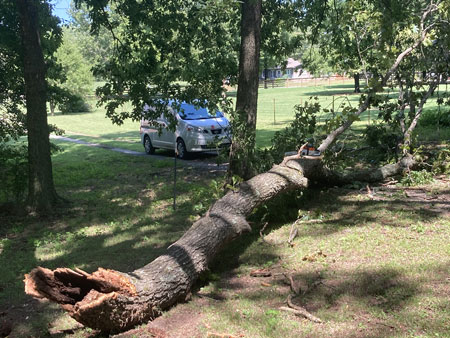Sudden Limb Breakage
Contact
University of Arkansas System Division of Agriculture
Cooperative Extension Service
2301 S. University Ave.
Little Rock, AR 72204

Sudden Limb Breakage
Returning home on Labor Day weekend my driveway was blocked by a limb lying across the path. A really big limb. It was 45 feet long with an 18-inch diameter. As I’d passed under this very same limb just hours before, I was glad it gave way after my exit.
Sudden limb breakage, or fall, goes by a number of names including summer limb drop, falling limb syndrome and several other phrases that convey the suddenness and unexpected nature of the phenomenon. Surprisingly, these limbs often break 3 to 10 feet from where the limb attaches to the tree trunk and there is usually no indication of defect or decay. Usually there is no splintering of wood; instead, just KAPOW, and a giant limb is plummeting towards earth. And to add to the mystery, sudden limb breakage occurs on still, often warm, days in the summer when there is no apparent reason for a strong, healthy limb to be ripped from high in the crown of the tree.
The black oak limb that fell across my driveway was hollow near the main trunk but, according to physicists, hollow pipes, reeds, and tree trunks are stronger than a solid form made of the same material. While this may be mathematically true for most materials, it seldom applies with trees because a hollow tree usually has several rotten defects that extend to the surface, weakening the strength of the tube.
This is the second case of sudden limb breakage I’ve encountered, though you see random limbs lying about if you notice such things. The first was a perfectly sound post oak that dropped a 6-inch limb about 5 feet from the main trunk. It can happen with any kind of tree but oaks, maples, ash, sycamore, elms, eucalyptus and other such large trees – probably because they are the largest and most commonly encountered – are most often reported. Usually, the limbs that break are growing horizontally with branches swooping up near the end.
The question of why these limbs break is subject to debate. A structural engineer would say that the break occurred when the load bearing capacity of the limb was exceeded by the weight of the load it is carrying. The fact that the load bearing capacity of the limb is less than a few feet from the tree trunk is because limbs form what is called “tension wood” on the upper side of a limb that contains higher levels of cellulose, and thus stronger cells. More of this tension wood forms closer to the trunk than farther out on the limb.
We’ve been fortunate to have good late summer rains, so there was plenty of moisture in the soil. That day the weather was still, not especially hot, but the relative humidity was fairly high. My conjecture is that the tree was not transpiring a great deal because of the higher humidity and comfortable temperature, so water accumulated in the tissue. At some point the load —weight of the wood and un-transpired water — exceeded the tensile strength of the limb, and it suddenly failed.
OSHA – the government people who keep track of such things – say that about 100 people a year are killed by falling trees. The majority of these are people engaged in felling a tree. The second cause of fatalities is tree-fall during storms. A few, usually one or two a year, are killed by sudden limb breakage during the summer. Twenty or so years ago a college freshman enjoying a free Sunday afternoon concert in Conway was killed by a falling limb. A jogger suffered a broken arm on a Fayetteville trail from a similar incident a few years back. While the odds are low, it can happen.
There is no reliable way to predict which limbs may suddenly break and fall to the ground. Some may advise against putting garden benches or picnic tables beneath the limbs of the biggest, oldest trees but that seems a bit excessive to me. Our lives are enriched by the presence of trees, but there is a modicum of risk in everything we do, even sitting in the shade enjoying the solace of nature.
